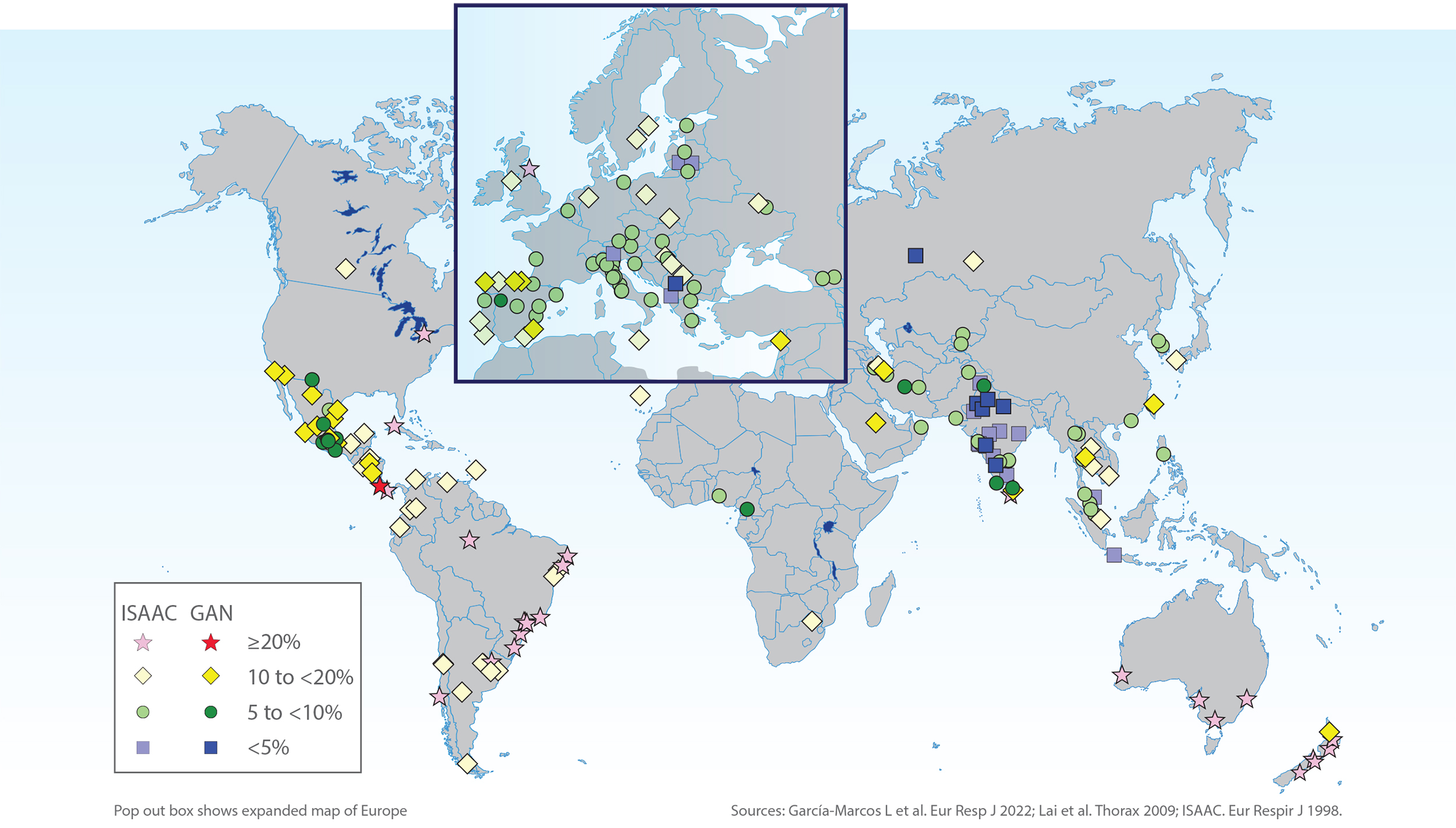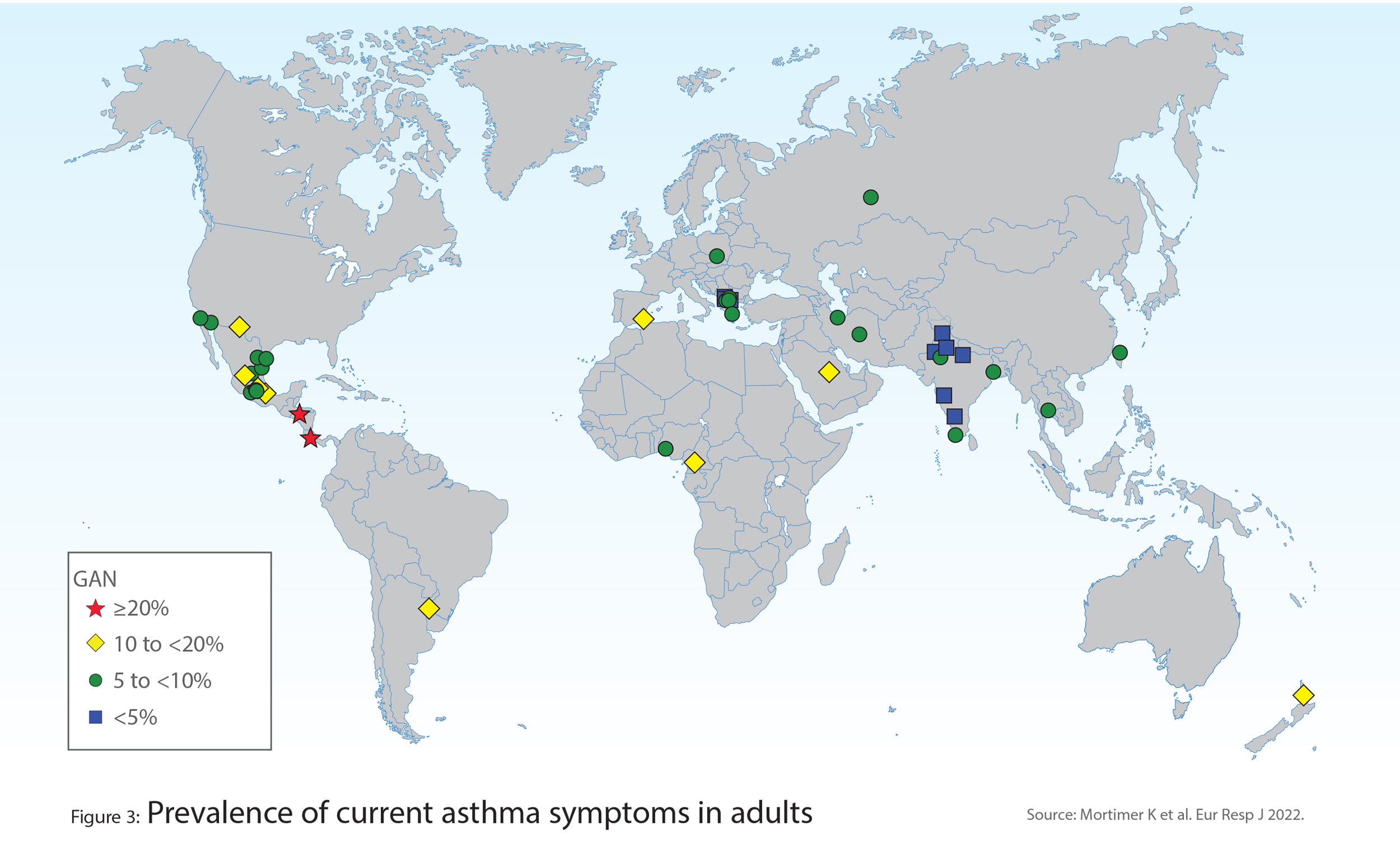
Global Burden of Disease due to Asthma
Asthma is a chronic disease affecting people around the world at all life stages. Severe disease may cause a substantial burden on individuals and health services, including premature death or a severely reduced quality of life. Global patterns are similar across children, adolescents and adults but the burden in terms of prevalence and severity of disease is highest in adolescents.
How many people have asthma?
The prevalence of asthma is hard to estimate globally due to differences in survey methods, and in the diagnosis and reporting of asthma. The Global Asthma Network (GAN) Phase I assessed prevalence of asthma symptoms between 2015-2020 via questionnaires, using the same standardised study protocol as the International Study of Asthma and Allergies in Children (ISAAC), Phase I 1992-1995 and Phase III 2000-2003. School pupils aged 13-14 years (adolescents), and optionally aged 6-7 years (children) participated from centres selected within a geographical sampling frame. Additionally in GAN, there was an option to include parents/guardians of the adolescents and/or children as an adult group. All three age groups answered a question on whether they had experienced wheezing or whistling in the chest in the past 12 months; a positive answer was used to calculate the prevalence of current asthma symptoms.
GAN Phase I surveyed 101,777 children in 44 centres within 16 countries, 157,784 adolescents in 63 centres, within 25 countries, and 193,912 adults (54% female; median age 38, interquartile range 33, 43) in 43 centres within 17 countries. For each age group, Figures 1-3 show prevalence of current asthma symptoms by centre in GAN Phase I, and for children and adolescents (Figures 1 and 2), the most recent ISAAC result where GAN data was not available. Similar to ISAAC Phases I and III, GAN Phase I showed wide variations between centres, both within and between countries. Across all age groups Indian centres had generally low prevalence. Asian and Eastern European centres were slightly higher, followed by Mexican and South American centres. For adolescents and children, highest rates were generally seen in English speaking countries in ISAAC but not many English speaking countries completed GAN Phase I.
The overall prevalence of current asthma symptoms in GAN Phase I was 9.1% for children, 11.0% for adolescents, and 6.6% for adults. This differed by country income level with lower prevalences across all three age groups in low- to lower-middle-income countries and highest prevalences in high-income countries (Figure 4). Overall, wheeze prevalence in children and adolescents has remained fairly stable from ISAAC Phases I to III and to GAN Phase I, though some individual centres have changed substantially. In general, low-income countries saw a small decrease of prevalence of current asthma symptoms but lower-middle-income countries saw an increase.
Much less is known about the prevalence of asthma symptoms in adults. This reflects both a paucity of survey data and the greater difficulty of distinguishing asthma from other respiratory conditions, such as chronic obstructive pulmonary disease (COPD), in older age groups. There have been no internationally standardised comparisons of prevalence of asthma symptoms in the elderly.
In terms of overall numbers, the Global Burden of Disease Study (GBD) estimated that in 2019, there were 262 million people affected by asthma, equating to an age-standardised rate of 3416 cases per 100,000 population.
What is the impact of asthma on people’s lives?
GAN Phase I defined severe asthma symptoms as current asthma symptoms along with 4 or more attacks of wheeze, waking at night with asthma symptoms one or more times per week, and/or any episodes of wheeze severe enough to limit the ability to speak, over the past 12 months. Results showed that between a third and one half of children, adolescents and adults with asthma symptoms, have severe symptoms that regularly interfere with everyday life. Children and adults in upper-middle-income countries had a higher proportion with severe asthma symptoms than those in low- to lower-middle- or high-income countries whereas adolescents had a high proportion of severe asthma symptoms across all income levels (Figure 4). However, there is some evidence that the prevalence of severe asthma symptoms in adolescents has been gradually decreasing over the past 27 years.
Burden of disease is a measure of health loss attributable to specific diseases. GBD has used prevalence, mortality statistics and health survey data, where available, to estimate two components of disease burden: years of life lost due to premature death (YLL); and years of life lived with disability (YLD). YLL and YLD are added together and expressed as disability adjusted life years (DALYs). YLD quantifies both the extent of disability and its duration. The GBD 2010 categorised asthma disability into three categories: controlled asthma; partially controlled asthma (wheezing and cough once a week, causing some difficulty with daily activities); and uncontrolled asthma (wheezing, cough and shortness of breath more than twice a week, causing difficulty with daily activities and sometimes waking the person at night).
GBD estimated that in 2019, there were 21.6 million DALYs attributed to asthma across all ages globally and asthma was ranked 34th among the leading causes of burden of disease, responsible for a fifth of total DALYS from chronic respiratory diseases. Almost half of the burden attributable to asthma was due to the 10.2 million YLD. Asthma was ranked 24th in the leading causes of YLD globally in 2019, the burden being slightly higher in males than females.
How can we improve this?
The burden of asthma is high, measured by prevalence, severity of asthma symptoms and premature death. Effective management of asthma needs to be implemented everywhere to mitigate the consequences of severe disease. Further standardised monitoring of the burden of asthma in all age groups is needed and finding ways to prevent asthma are vital.




